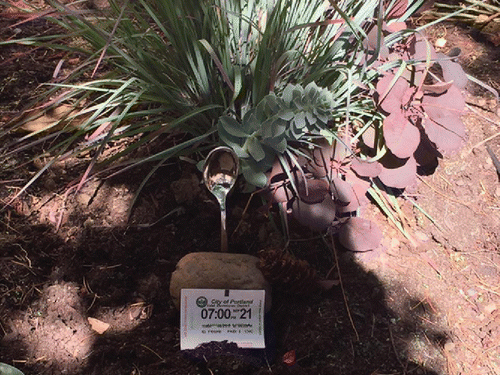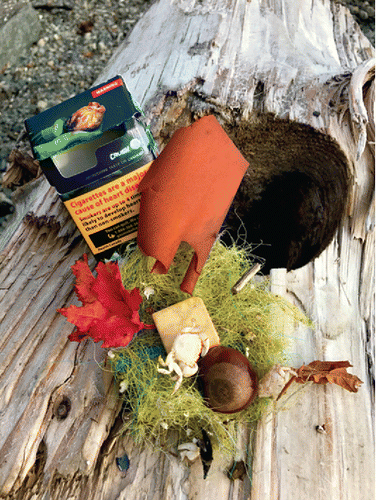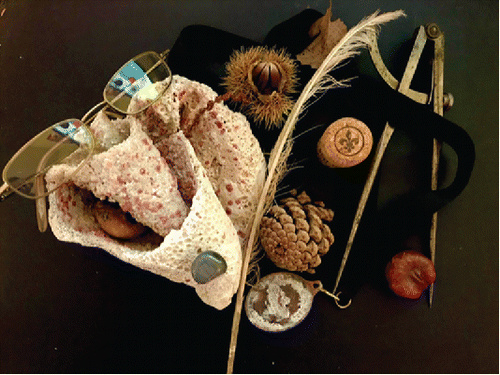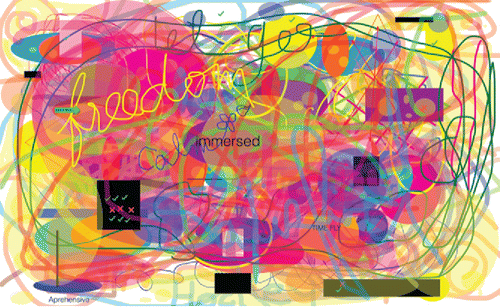Aspirations of multiculturalism in our society and therapeutic practices are developing conversations regarding cultural competency among mental health professionals. Given the complexity of cultural diversity, it can be helpful to frame cultural knowledge as a process rather than a goal—a process that does not assume authority, but rather a fluidity of addressing contributing factors to cultural identities. It also includes our beliefs and attitudes toward our clients and ourselves. These reflections incorporate cultural humility, as described in a thought provoking article by Jaspreet Bal and Rapinder Kaur entitled “Cultural Humility in Art Therapy and Child and Youth Care: Reflections on Practice by Sikh Women.” This article roots the theme of this special issue entitled Creative Agency and Political Responses Through Arts Therapy, the 2017 theme of the Canadian Art Therapy Association conference held in Vancouver.
The Canadian International Institute of Art Therapy (CiiAT) attracts students from around the world. As an international art therapy training program, hosting coursework in three languages in three countries (Japan, Thailand, Canada), we are an increasingly culturally complex group of faculty, staff, and students. One of our core values has become cultural humility, as it is an understanding that values learning through reciprocal relationships rather than the acquisition of factual knowledge pertaining to a particular culture. Jaspreet Bal and Rapinder Kaur describe cultural humility as a critical reflection regarding personal and systemic biases, it is a respectful approach to relationships based on mutuality that interrogates cultural assumptions and judgments (Bal & Kaur, Citation2018). Underlying cultural humility is the knowledge that we are never finished—we do not arrive at a point when our cultural education is complete. We must be bold enough to look at ourselves critically, and acknowledge how understanding is only as powerful as the action that follows.
Online classes as a practice ground for cultural humility
During our CiiAT online courses, students and instructors join together for several hours of classes at a time. Logging-in for class, we prepare a personal, confidential space to talk together. We are sitting in our studios, or homes, spending time together in an educational partnership (). We are women and men, gay and heterosexual, 28–86 years of age, Catholic, Buddhist, Muslim, civilian and military, parents and non-parents. We are living in Egypt, Thailand, Japan, Taiwan, Canada, the United States, and the United Arab Emirates. We speak many languages, but we communicate in English and through the language of art. Classes are small enough that we can see each other on the screen, face-to-face.
As an instructor, many of the activities I traditionally use in on-campus art therapy courses need to be modified or discarded. How could I accomplish learning outcomes with students thousands of miles apart? How could I create a safe space that fosters the structure and support I was familiar with in a single classroom?
One ritual I initiated was a collaborative online whiteboard drawing to connect students after they logged-in for class (). I invited students to draw in this virtual context, and it became a playground of markings made through the exploration of technology tools, fonts, and colors. As it is not possible to identify who made which marks, we talk about each person's contributions. The online whiteboard is a supportive tool, rather than a distancing one, a meeting place for opening remarks and personal sharing.
Figure 1. CiiAT Class Online. Top row, left to right: Michelle Winkel, CAJ, Madison Mikel. Middle row, left to right: Patty Prachayaporn Vorananta, Pin-ju Chen, Kaitlin Jane. Bottom row, left to right: Colin Peters, Piyatchit Panomvana.

When students meet from around the world in a physical classroom, they adapt to the country where they are gathering. It is an adjustment of the students' regular way of being. Yet when we meet online, still seated in our homes, students remain in their own environment, embedded in their own culture and in their own personal spaces. This makes them somewhat “more themselves” and therefore we experience an authenticity not always so obvious on campus. I was getting to know the students after just a couple of classes, so my curiosity about them grew, and my hesitation about the technology waned. Next, I wanted to increase the collaborative element of the class.
Rituals of connection
One week I asked each student to go on a meditative walk in their neighborhood and choose several discarded objects they disliked and several objects they were attracted to. I then asked them to create a sculpture outdoors within their community, encompassing those chosen objects. The following class students shared images of their sculptures online, each explaining how their particular sculpture embodied objects they both loved and disliked. This activity turned out to be very powerful for the class and for me as instructor. Seeing the sculptures in their landscapes made us imagine the student in that place—from tropical greenery and skyscrapers, to east coast rocky beaches, to northern snow, to west coast nature. Students shared their habitats and how they felt about their home environments. The elements of geography and place brought us closer together as a group.
Madison Mikel describes her piece “Time Based Object Harvest” ():
This is a collection of found objects gathered on a Portland, Oregon walk. The spoon represents “feeding” or “being fed” by my surroundings, and the parking permit denotes “time.” I was trying to emphasize the time it took for me to take in my surroundings. The spoon, made of plastic, represents the decay and litter of humans within the beauty of the earth as well as the eating away of time.
Figure 3. Madison Mikel, “Time-Based Object Harvest,” Portland, Oregon. Objects: Metallic plastic spoon, parking permit, rock, plants, and branches.

Figure 4. CAJ, “Caught by the Tide,” Vancouver Island. Objects: Crab shell, cigarette box, driftwood, bark, chestnut, leaf, eraser, and moss.

Another student, CAJ, created “Caught by the Tide” from a collection of found and gathered objects placed upon driftwood on a Vancouver Island, British Columbia, beach ().
In another art activity, I covered a long table with black cloth and randomly spread objects—a medallion, bottle cork, old toys, wooden tools, stones, radio parts, buttons, boxes, feathers, plastic objects, a pencil compass, watch parts, and so on, onto the table in my studio (). I filmed the table with a video camera so students could study the objects presented. I asked each student to select an object and direct its placement to a new location. How I was directed to place each object was of personal significance to the student. A dance of objects ensued—back and forth, over and under—until everyone felt pleased and satisfied with the final assemblage. Discussing the process afterward, students described the exercise as a valuable lesson in verbalizing wants and needs, sharing space, and surrendering control.
Figure 5. “A Collection of Emotions.” Students: Colin Peters, Patty Prachayaporn Vorananta, Madison Mikel, Haniya Al Aziz, Kaitlin Jane, Pin-ju Chen, Piyatchit Panomvana, CAJ. Objects: Black velvet, antique compass, corroded metal, eyeglasses, chestnut, sprouted acorn, conch shell with stone inside, glass bead, feather, pinecone, cork, and leaf.

Reflecting both upon the political responses theme of this issue and the topic of cultural humility, two students from CiiAT shared stories of connection. One student, Colin Peters of Halifax in Nova Scotia, Canada, who served several tours of duty in the Middle East, related cultural humility to the ability of an art therapist to understand military culture. This includes specific acronym-heavy language, very dark humor, swearing, and an awareness of body language used to hide one's feelings and to survive in the field. He suggested that art therapists working with military personnel should not ask: “So what have you seen?” This question implies a lack of understanding of military fieldwork and suggests an art therapist has not taken the time to learn about military life from first-hand accounts.
Another CiiAT student, Haniya Al Aziz, from Cairo, Egypt, spoke about her experiences bridging cultural differences in a practicum. She was invited to work in a prison in the United Arab Emirates with men who had spent approximately three years incarcerated for various addictions and related offences. The art therapy student shared the men's Arabic language, but with a slightly different dialect, having grown up in Egypt. The group members were from broadly diverse educational backgrounds and literacy levels, so she was careful to keep her language focused on clarity and transparency. The artwork helped build trust. These men initially presented with aggression, but by the fourth session they were behaving differently as a result of working with clay. Traditionally utensils and pots were made from clay in the men's childhood homes. As many of the men had become estranged from their families, working with this material helped rekindle memories of their childhood and stories related to their families and friends.
Creative agency and political responses through arts therapy
CiiAT has benefited from an inaugural collaboration with the Canadian Art Therapy Association Journal. This association marks the development of partnerships between the journal and art therapy education programs within Canada. CiiAT students were involved in peer reviewing and submitting content for the editorial. This issue also features an article by CiiAT faculty member Patricia Rose Williams on the development of creative agency through the combining of self-compassion, mindfulness, and art therapy through the ONEBird model, and includes a book review by Santoshi (Tammy) Robertson-Davis highlighting the recent publication of Attachment Informed Art Therapy: Strengthening Emotional Ties Throughout the Lifetime by CiiAT's Founding Director Lucille Proulx. Patricia's article showcases not only the creative agency of ONEBird (where mindfulness and compassion take flight within art therapy) but offers an inspiring artistic approach to self-compassion incorporating psychoeducation, creative expression, and psychological analysis. Lucille Proulx has elaborated upon attachment throughout the lifetime (including the final stages of life), and applied art therapy techniques to challenges of attachment faced by people in a variety of life situations. This book exudes wisdom gained from Lucille's impressive career promoting attachment theory innovations and applications for the betterment of all people.
Another notable feature of this issue is the voices of two art therapists who encourage art therapy to enact alliances with Indigenous peoples. Jennifer Vivian proclaims a call to action to encourage art therapists, and the profession of art therapy, to address both decolonization and reconciliation. Jennifer is launching an Indigenous circle for both Indigenous and non-Indigenous art therapists. The goal of the circle is to develop ethical guidelines for working within Indigenous communities and to offer mentoring between Indigenous and non-Indigenous art therapists. On the same subject, Tzafi Weinberg advocates for non-Indigenous art therapists to further their cultural responsiveness through partnerships with Indigenous art therapy mentors in order to promote ethical standards of practice within Indigenous communities. Tzafi's work with Indigenous children and youth in foster care underlines the necessity of working with cultural consciousness and respect for Indigenous traditions, knowledge, and community protocols.
Furthering an examination of both cultural humility and political responses through arts therapy, Alexandra Hanania elaborates upon the potential for embroidery to be used as a culturally relevant art therapy medium with Syrian women establishing new lives in Canada. Art therapy materials are not exempt from bias and can be utilized without due consideration for their potential prejudice. The key is to facilitate choice and democratize the art therapy experience through open communication. Care must be taken not to export assumptions, and to give voice to the determination of art therapy participants to represent their identities with culturally relevant materials.
Two additional book reviews are written by Heather Sanrud and Darlynne Hildebrandt. Heather explores the artistry of expressive arts therapists in a recently published book entitled New Developments in Expressive Arts Therapy: The Play of Poiesis by Ellen G. Levine and Stephen K. Levine. This book is an art therapy studio, a collection of offerings to further develop the artist identity of arts therapists. It is alive with inspiration, invigorating perspectives, and challenges to make art therapy that much more creative. Darlynne's review of DBT-Informed Art Therapy: Mindfulness, Cognitive Behavior Therapy, and the Creative Process by Susan M. Clark offers a rich description of art therapy informed by dialectical behavior therapy (DBT). Her review showcases how therapeutic complexity (the ability to consider opposing perspectives) is addressed by art therapy's ability to illustrate contradictions while facilitating accomplishment—or the mastery of using metaphors to promote self-efficacy.
As usual, I am stirred by the diversity and originality of the articles and book reviews in this journal. Thanks to the authors for their commitment and courage documenting their work and sharing it. I hope you will find value and inspiration in this issue. As we all practice navigating through culturally complex experiences with our clients, friends, and colleagues, we appreciate and rely on our art practices, our creative process, and the images that emerge.
Reference
- Bal, J., & Kaur, R. (2018). Cultural humility in art therapy and child and youth care: Reflections on practice by Sikh women. Canadian Art Therapy Association Journal, 31(1), 6–13.

